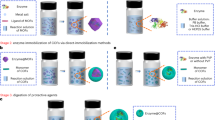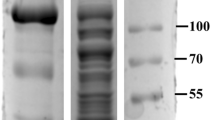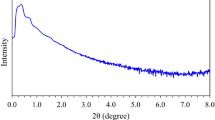Abstract
ENZYMES have been covalently linked to organic polymers1–7 or immobilized in starch8 and acrylamide gels9. These derivatives are susceptible to microbial attack, and, when used in chromatography columns, vary in flow rates and apparent pore size with changing pH and solvent conditions. Here I describe the covalent coupling of bacterial alkaline phosphatase (Worthington Biochemical Corp., Freehold, NJ) to an inorganic carrier, porous glass, thereby eliminating many problems inherent in the use of organic carriers. Inorganic carriers, for example, are not susceptible to microbial attack; by using a glass in which the pore diameter is smaller than that of a bacterial cell, the enzyme cannot be utilized as substrate unless the organism produces an extra cellular protease, and porous glass is unaffected by the changes in pH and solvent conditions generally associated with the use and study of biological molecules.
This is a preview of subscription content, access via your institution
Access options
Subscribe to this journal
Receive 51 print issues and online access
$199.00 per year
only $3.90 per issue
Buy this article
- Purchase on Springer Link
- Instant access to full article PDF
Prices may be subject to local taxes which are calculated during checkout
Similar content being viewed by others
References
Bar-Eli, A., and Kalchalski, E., Nature, 188, 856 (1960).
Bar-Eli, A., and Kalchalski, E., J. Biol. Chem., 238, 1690 (1963).
Goldstein, L., Levin, Y., and Kalchalski, E., Biochemistry, 3, 1905 (1964).
Alexander, B., Rimon, A., and Kalchalski, E., Fed. Proc., 24, 804 (1965).
Goldman, R., Silman, H., Caplan, S., Kedem, O., and Kalchalski, E., Science, 150, 758 (1965).
Mitz, M., and Summaries, L., Nature, 189, 576 (1961).
Hornby, W. E., Lilly, M. D., and Crook, E. M., Biochem. J., 107, 669 (1968).
Bauman, E., Goodson, L., Guilbault, G., and Kramer, D., Anal. Chem., 37, 1378 (1965).
Updike, S., and Hicks, G., Nature, 214, 986 (1967).
Baum, G., Messing, R. A., and Weisz, P. F., J. Biomed. Mat. Res. (in the press).
Campbell, D. H., and Weliky, N., in Methods in Immunology and Immunochemistry (edit. by Williams, C. A. and Chase, M. W.) (Academic Press, New York, 1967).
Lineweaver, H., and Burke, D., J. Amer. Chem. Soc., 56, 658 (1934).
Stadtman, T. C., in The Enzymes (edit. by Boyer, P. D. Lardy, H., and Myrbach, R.), 5, 55 (Academic Press, New York, 1961).
Author information
Authors and Affiliations
Rights and permissions
About this article
Cite this article
WEETALL, H. Alkaline Phosphatase insolubilized by Covalent Linkage to Porous Glass. Nature 223, 959–960 (1969). https://doi.org/10.1038/223959a0
Received:
Issue Date:
DOI: https://doi.org/10.1038/223959a0
This article is cited by
-
Continous production of 1-kestose by ?-fructofuranosidase immobilized onshirasu porous glass
Biotechnology Letters (1991)
-
Immobilization of the restriction endonucleasesPvuII andHindIII
Applied Biochemistry and Biotechnology (1987)
-
ImmobilizedE. coli Alkaline Phosphatase
Applied Biochemistry and Biotechnology (1985)
-
Structural investigation of biological material in aqueous environment by means of infrared-ATR spectroscopy
Biophysics of Structure and Mechanism (1979)
Comments
By submitting a comment you agree to abide by our Terms and Community Guidelines. If you find something abusive or that does not comply with our terms or guidelines please flag it as inappropriate.



